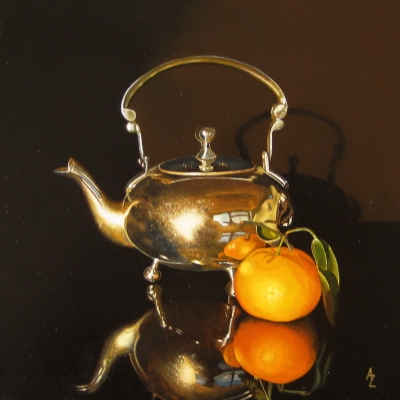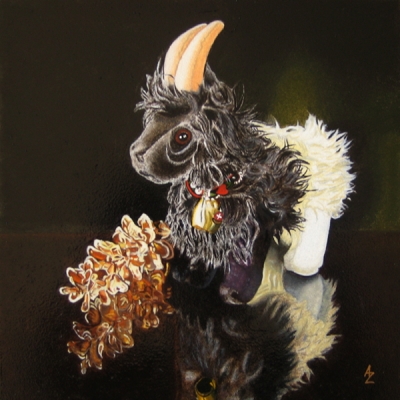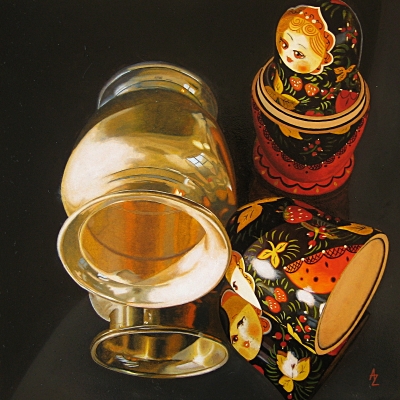Posts Tagged: reflections
Make Tea not War
6″ x 6″ (15 x 15 cm) oil on gessobord panel.
I am a tea buff, as in tea aficionado, tea connoisseur, but otherwise known as a tea snob. In our little tea universe we study and admire tastes, aromas and colors. We understand tea terminology, geography and pedigree. We frown at shredded tea leaf or added flavors. We are purists who mail our precious tea leaves from their countries of origin. Among us tea bags are an insult and Lipton is a dirty word. You get the picture. I am not gone that far on this tea road, but far enough to bring my tea with me when I travel.
And of course we admire teaware. Teaware is an art form in itself, many collect teaware, which can run up astronomical prices for historical and rare pieces. I am not a collector, but I have a few teapots. Different teas require different pots to bring out full flavor.
This little painting is of my silver teapot from England. Not particularly old or historically significant, but it is pretty and I like it for Ceylons or Darjeelings. There is no deeper meaning here, I just wanted to paint a silver teapot. Check out the multiple reflections of the clementine! And because it is an simple painting I thought a line from Monty Python is particularly suited for the title.
Eiger Trail
6″ x 6″ (15 x 15 cm) oil on gessobord panel.
In the year 2000 my husband and I went to Switzerland and did some wonderful mountain hiking. The absolutely amazing experience was the Eiger Trail near Gimmelwald. I was completely spellbound with its majestic beauty. So much so that I even bought a local souvenir (which I never do, btw) – a local goat toy. These goats are the funniest critters – black in the front, white in the back, curious and fearless creatures. This still life is another one in the Reflections series I am working on.
A few days ago my friend and artist Carol King (Carol King blog) asked about process and steps it takes me to paint these still lives. An excellent question that I promised to answer.
My process:
I usually start with an idea. The idea can be visual – color I like, line that is intriguing, texture I haven’t tried before. Or it can be intellectual – memories, poetry, or emotions that touched me. This idea brings forward objects that could express it. I often have to hunt for these objects in thrift stores or borrow them from my friends and family – sorry, guys!
I make numerous compositions from objects I assembled and experiment with light. Following Norman Rockwell’s methods I take dozens of photos of my various setups in various lights.
Bringing the photos to my computer I sort and discard. With the remaining few I work on crop and composition. Half the time I can’t get an image that satisfies, and when this happens I go back to playing with my objects and light and camera.
Once I have a composition I like, I draw it in pencil. I often use grid method working from my computer screen and make my drawing as accurate as I can. At this stage I make decisions about details and routinely skip and omit portions that I don’t want in a future painting.
I rub the back of the drawing with vine charcoal creating a transfer surface and transfer the image onto the gessobord. Gessobord by Ampersand is my preferred surface because it is very smooth. The transferred charcoal image gets corrected and then fixed with Krylon fixative.
When fixative is dry I put in an imprimatura layer. I like my paintings to have warmth coming from within, so my usual imprimatura is done in yellow ochre or burnt sienna or burnt umber or a combination of them.
I use Gamblin oils, Gamsol for solvent, and Galkyd Slow Dry medium. Here is the list of my colors:
- yellow ochre
- burnt sienna
- burnt umber
- alizarin crimson
- venetian red
- cadmium red light
- cadmium yellow light
- cadmium yellow medium
- cadmium orange
- viridian
- ultramarine blue
- cerulean blue
- payne’s grey
- portland grey
- ivory black
I use two whites – titanium and flake white.
I would give you my preferred brushes too, except I don’t have them. I have many brushes I use and dislike to various degrees, some more and some less. But I haven’t found brushes that would do what I want without a struggle. I will write about brushes in another post.
I use several sources as references for painting. I paint from the laptop screen, which is very convenient because I can enlarge details and lighten darks to see better. And I use a printed reference, which is convenient in a different way because I can rotate it. I also have my objects present so I can see the real colors.
I wait until my imprimatura layer is dry and begin the background. I usually work background to foreground and dark to light. The difficulty starts when my background is light and foreground is dark. In this case I abandon reason and work easy passages first and difficult ones later.
I let the background dry overnight. I prefer it to be reasonably dry, but it is not a must. If it is still tacky next day, I begin painting my foreground composition anyway using a painting bridge.
It usually takes several days to paint the first color layer. When the first layer is dry to touch I often do a coat of retouch varnish to even up sunken colors and assess where I am.
Then I do the second color layer, correcting, deepening, creating variations, adding details and brightening highlights. I may use Galkyd medium in the second layer.
Second layer complete I add another coat of retouch varnish and assess again. Often at this stage the painting begins to speak to me, telling me it is time to round things up. When I hear that, I correct mistakes I can find and get out my “Finishing a Painting Checklist.”
Reading books, blogs, talking to painters and making paintings myself I compiled a list of things to check at the final stages of a paining. I go through it and check and correct things. But it is not as analytical as it sounds. Sometimes I see something that needs changing according to my list, but I like it the way it is and leave it. In fact, I disregard a lot of rules, some of them rather fundamental.
Against well known and well established rules:
- I paint flat on a table
- I use small, smaller and smallest brushes
- I love details and paint a lot of them
And I am unrepentant and unapologetic.
I sign my small paintings with initials only. When a painting is sold or goes to a show I add a label in the back with a title, media, my full name, and year painted.
I let my small oils dry for at least a week before I varnish them. I use Gamvar varnish applied with a brush.
A Dream within a Dream
8″ x 8″ (20 x 20 cm) oil on gessobord panel. To bid on this painting click here.
The painting was slow in coming, and I am not all sure why it took so long. I started it before Christmas. So OK, there was Christmas with all its Christmasy chores, then there was the New Year and a pressure to party, then Shelly went on her epic Israeli trip. Where did the time go…
I am doing a small series under a working title Reflections. The idea is to connect memories with images reflecting in a mirror. I am working on another painting along these lines that is nearly finished.
In this one I hoped to connect to my former country. I tried to work out the anger I still feel even now, almost a quarter of century since I left. When I try to be rational I can come up with things that were good back then, 25 years ago, but list is rather short. I remember being young was fun, ahh… good times we had! Love Russian art, poetry, and music. Hmmm… love how mathematics was taught… Love my memories of hiking, sailing and amazing natural beauty. That’s about it. My other list – the “angry” one – is long and ugly, full of injustice, KGB and empty grocery stores.
The credit for the title of this painting goes to my daughter Shelly. Thank you, Shelly, it was brilliant!



